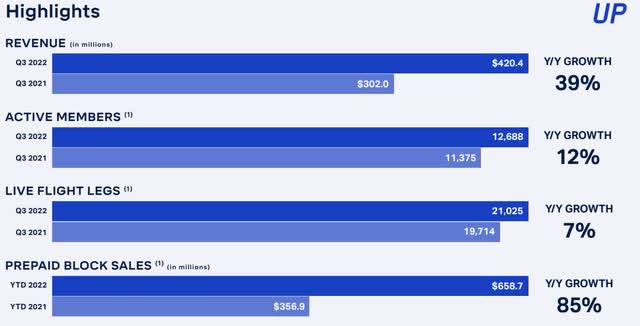Pinkypills/iStock via Getty Images
Wheels Up Experience Inc. (NYSE:UP) is an on-demand aviation company that provides private aviation services primarily in the U.S. market.
The company has been successful in growing revenue but has had difficulty turning a profit. I think the reason for that is it is trying to be all things to all its potential and existing customer base, which appears to be a frustrating experience based upon the enormous number of moving parts that the company is having difficulty bringing together in a cohesive manner.
While the company has laid out a very detailed plan on how to achieve positive adjusted EBITDA in 2024, I’m not convinced it’ll be able to do so as the company stands today.
In this article we’ll look at some of its recent earnings as well as why and how it may have to change in order to become profitable.
Latest earnings
Revenue in the third quarter jumped to $420.4 million, up 39 percent year-over-year. The increase in revenue came from the acquisition of Air Power, an increase in flight demand, and higher revenue per Live Flight Leg.
Net loss soared from $27.4 million last year in the same reporting period, to a net loss of $86.8 million in the third quarter of 2022. Net loss was up “due to higher operating expenses, including higher technology spend and a broad-based equity grant to the Wheels Up employee pilots.”
Adjusted EBITDA for the reporting period was -$45.2 million, down by $21.3 million from the third quarter of 2021. Inflation and supply constraints resulted in lower flight margins, along with technology investments.
UP boosted its cash position via an issuance of $270 million in equipment notes through a EETC loan structure.
Its active customer base increased to 12,688, a gain of 12 percent year-over-year. The improvement was attributed to new “member sales and strong membership retention.”
Live Flight Legs were up to 21,025, an increase of 7 percent from last year in the same reporting period. Growth in active members and the acquisition of Air Partner were the primary catalysts there.
Revenue per Live Flight Leg increased 20 percent to $13,266 from last year in the third quarter. and excluding Air Partner, was up 25 percent. That points to organic pricing power with its existing customer base before it acquired Air Power. Other contributions included adding a fuel surcharge and “a shift in the mix of cabin flying.”
The company held cash and cash equivalents of $545 million at the end of the third quarter, with long-term debt of $270 million. Operating lease liabilities stood at $117 million.
Company challenges
UP is doing well in driving revenue growth, but the costs of doing so are high. The company is working on streamlining and consolidating operations in order to achieve its goal of having adjusted EBITDA profitability in 2024.
Demand isn’t the issue for UP, it’s bringing disparate pieces of the business together in a way that allows it to generate a profit. To do so, the company may have to make some changes to its business structure, by which I mean zeroing in on defining who its base customer is, among other things.
Something CFO Todd Smith said in the earnings report is among one of the important things the company has to deal with, especially in regard to deciding who their customers are. He said: “But we continue to evaluate membership growth relative to our capability to execute and deliver at the service level that our customers expect.”
Not only does that relate to its need to define its core customer, but it, in a nutshell, also describes the major challenge the company faces, which is, as Smith stated, the capability to offer quality service in the face of rapid growth in the number of customers it serves.
In other words, it may need to slow down its customer growth initiative and work on improving its service. Or to put it another way, it may have to sacrifice some revenue in the near term before aggressively pursuing growing market share. It can do both of course, but the company will probably be forced to moderate its growth until the quality of its service improves by adding more employees and timely training.
One of the things the company is working on is to use technology to transform the on-demand aviation industry by improving customer experience. The company also believes by doing so it will be able to attract “more consumers at the top of the funnel.”
Being able to attract higher end consumers will be important for UP because they have more disposable income (including businesses), and as service improves the company has room to raise prices which it could have trouble doing with other consumers. This is a major reason I said the company probably will have to better define who its core customer is.
That doesn’t mean it won’t have other customers it serves at different price points, depending on a number of variable and customer needs, only that by adding higher end customers it will be a big step in progressing toward its goal of EBITDA profitability in 2024.
A lot of the reason for the challenges UP faces, outside of normal business practices, is that by building the business primarily through a series of acquisitions, which along with its processes being manual in nature at this time, has resulted in much higher costs than the company should have.
Applying technology to its processes and bringing far more synergy to the disparate pieces of the business will go a long way toward solving the many operational challenges the company faces, including dispatch and maintenance availability, and consolidating operations.
One positive step the company is taking is in building its new Member Operations Center (MOC) in Atlanta, which will help centralize communications in regard to “flight, customer interaction and maintenance functions.”
Conclusion
As mentioned earlier in the article, one of UP’s strengths is to grow its customer base and revenue – primarily via acquisitions, but also organically. The major challenge the company faces is in consolidating operations in order to remove a significant amount of costs in order to become profitable.
The major things it needs to do in my opinion are add and apply better technology to its processes, increase hiring to handle lack of efficiencies in some areas of the company, improve training, work on improving synergies among the various businesses it has acquired, and last but not least, moderating its pace of customer acquisitions until it can have the service personnel and quality in place to serve its customer base. UP’s business, on the operational side, is a complex one. The bad news is it’s struggling to bring all the pieces of the puzzle together in a coordinated way that allows for a sustainable path to profitability. The good news is, if it’s able to solve these problems, it’s going to be a huge moat against its competitors.
Even if some of the issues can’t be solved, I think the company could do very well if it decided to cut back on some of its ambitions across the services it wants to offer to a variety of consumers, and maybe cut back to the point it can do what it offers at a very high level.
For now, I think UP is going to continue to struggle on cost and earnings because it’s going to take time to solve its problems as the company stands today; and the challenges are formidable.
Considering the company has bounced off its 52-week low of $0.99 and is trading at $1.57 as I write, I don’t think this is a good place to enter the trade. For investors believing in the long-term prospects of UP, it would probably be better to wait for a pullback before taking a position in the company.



Be the first to comment